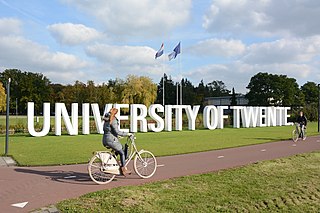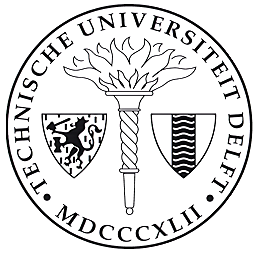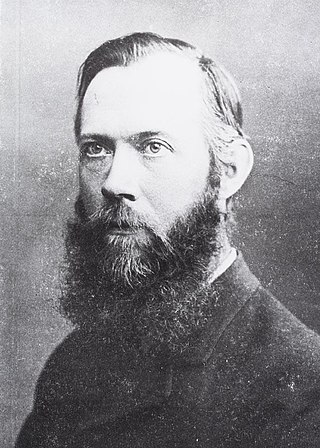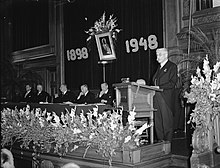
Delft is a city and municipality in the province of South Holland, Netherlands. It is located between Rotterdam, to the southeast, and The Hague, to the northwest. Together with them, it is part of both the Rotterdam–The Hague metropolitan area and the Randstad.

The University of Twente is a public technical university located in Enschede, Netherlands. The university has been placed in the top 170 universities in the world by multiple central ranking tables. In addition, the UT was ranked the best technical university in The Netherlands by Keuzegids Universiteiten, the most significant national university ranking. The UT collaborates with Delft University of Technology, Eindhoven University of Technology and the Wageningen University and Research Centre under the umbrella of 4TU and is also a partner in the European Consortium of Innovative Universities (ECIU).

Delft University of Technology, also known as TU Delft, is the oldest and largest Dutch public technical university, located in Delft, Netherlands. As of 2022 it is ranked by QS World University Rankings among the top 10 engineering and technology universities in the world. In the fields of architecture and civil engineering, it was ranked 2nd in the world, after MIT.

Antonie “Anton” Pannekoek was a Dutch astronomer, philosopher, Marxist theorist, and socialist revolutionary. He was one of the main theorists of council communism.

In botany, phyllotaxis or phyllotaxy is the arrangement of leaves on a plant stem. Phyllotactic spirals form a distinctive class of patterns in nature.

David van Dantzig was a Dutch mathematician, well known for the construction in topology of the dyadic solenoid. He was a member of the Significs Group.

Simon de Vlieger was a Dutch painter, draughtsman and designer of tapestries, etchings, stained glass windows. While he is mainly known for his marine paintings he also painted beach scenes, landscapes and genre scenes.

Diederik Johannes Korteweg was a Dutch mathematician. He is now best remembered for his work on the Korteweg–de Vries equation, together with Gustav de Vries.

Warner Tjardus Koiter was an influential mechanical engineer and the Professor of Applied Mechanics at Delft University of Technology in the Netherlands from 1949 to 1979.

Wilhelm Friedrich Philipp Pfeffer was a German botanist and plant physiologist born in Grebenstein.

Johannes de Groot was a Dutch mathematician, the leading Dutch topologist for more than two decades following World War II.
Gerrit is a Dutch male name meaning "brave with the spear", the Dutch and Frisian form of Gerard. People with this name include:

Gerrit Mannoury was a Dutch philosopher and mathematician, professor at the University of Amsterdam and communist, known as the central figure in the signific circle, a Dutch counterpart of the Vienna circle.
The history of the Delft University of Technology started in the year 1842 with the foundation of the Royal Academy (1842–1864). The Royal Academy restarted in 1864 as the Polytechnic School (1864–1905), which evolved the Delft University of Technology in 1905.

Adriaan Cornelis "Aad" Zaanen was a Dutch mathematician working in analysis. He is known for his books on Riesz spaces.
Dirk Willem van Krevelen was a prominent Dutch chemical engineer, coal and polymer scientist. He successfully combined an industrial career, managing a research division at DSM, and an academic career, as a Professor of Delft Technical College. His contributions span a wide range of research fields, and his name is linked to the van Krevelen–Hoftyzer diagram for chemical gas absorption, the Mars–van Krevelen mechanism for catalytic oxidation reactions, the van Krevelen–Chermin method to estimate the free energy of organic compounds, the van Krevelen diagram that is used in coal and coal processes, the van Krevelen method to calculate additive properties of polymers, and the van Krevelen–Hoftyzer relationship on the viscosity of polymer fluids.

Frederik Karel Theodoor van Iterson was a Dutch mechanical engineering professor, who largely developed the typical design of power station natural draught cooling tower, being built from 1918.

Frank den Hollander is a Dutch mathematician.

Johannes Maria Jozef"Hans"van Leeuwen is a Dutch physicist.
Gerrit van der Mey was a deafblind Dutch mathematician. He helped create software for PTERA and ZEBRA, some of the first computers designed in the Netherlands, as well as creating compilers for later computers. In 1982 he was made a member of the Order of Orange-Nassau at the grade of knight.















